Global EV Comparison: Kia Soul EV Standard Range vs Tesla Model S 60
Struggling to Decide? Let AI Help!
Your AI Summary Is Ready!
General Info
The Kia Soul EV Standard Range (2020-…) is currently produced, it has a starting price of €38418. The Tesla Model S 60 (2013-2015) has been discontinued. You can find it for as low as €17999 on the used car market.
The Kia Soul EV Standard Range (2020-…) is a SUV, whereas the Tesla Model S 60 (2013-2015) is a Liftback.
| Property | Kia Soul EV Standard Range | Tesla Model S 60 |
|---|---|---|
| Years of Production | 2020-… | 2013-2015 |
| Current Status | Produced | Discontinued |
| Country of Manufacture | South Korea | Netherlands, USA |
| Body Style | SUV | Liftback |
| Market Availability | EU | EU, USA |
| Price Europe (New) | €38418 | - Price Europe (New) |
| Price Europe (Used) | €15999 | €17999 |
| GCC Score | 5.1 | 5.8 |
Range and Efficiency
While the Tesla Model S 60 (2013-2015) offers a longer real-world range and a bigger battery, it is less energy-efficient than the Kia Soul EV Standard Range (2020-…).
| Property | Kia Soul EV Standard Range | Tesla Model S 60 |
|---|---|---|
| Range (EPA) | - Range (EPA) | 335 km |
| Range (WLTP) | 276 km | - Range (WLTP) |
| Range (GCC) | 235 km | 300 km |
| Battery Capacity (Nominal) | 42 kWh | 61 kWh |
| Battery Capacity (Usable) | 39.2 kWh | 58.5 kWh |
| Efficiency per 100 km | 16.7 kWh/100 km | 19.5 kWh/100 km |
| Efficiency per kWh | 5.99 km/kWh | 5.13 km/kWh |
| Range and Efficiency Score | 5.4 | 5.1 |
Charging
Both vehicles utilize a standard 400-volt architecture.
The Tesla Model S 60 (2013-2015) offers faster charging speeds at DC stations, reaching up to 120 kW, while the Kia Soul EV Standard Range (2020-…) maxes out at 44 kW.
The Tesla Model S 60 (2013-2015) features a more powerful on-board charger, supporting a maximum AC charging power of 11 kW, whereas the Kia Soul EV Standard Range (2020-…) is limited to 7.2 kW.
| Property | Kia Soul EV Standard Range | Tesla Model S 60 |
|---|---|---|
| Max Charging Power (AC) | 7.2 kW | 11 kW |
| Max Charging Power (DC) | 44 kW | 120 kW |
| Architecture | 400 V | 400 V |
| Charge Port | CCS Type 2 | Tesla Type 2 (Mennekes) |
| Charging Score | 4 | 5.5 |
Performance
The Tesla Model S 60 (2013-2015) is rear-wheel drive, while the Kia Soul EV Standard Range (2020-…) offers a front-wheel drive system.
The Tesla Model S 60 (2013-2015) boasts greater motor power and accelerates faster from 0 to 100 km/h.
| Property | Kia Soul EV Standard Range | Tesla Model S 60 |
|---|---|---|
| Drive Type | FWD | RWD |
| Motor Type | PMSM | IM |
| Motor Power (kW) | 100 kW | 225 kW |
| Motor Power (hp) | 134 hp | 302 hp |
| Motor Torque | 395 Nm | 430 Nm |
| 0-100 km/h | 9.9 s | 6.2 s |
| Top Speed | 157 km/h | 193 km/h |
| Performance Score | 3.1 | 4.7 |
Dimensions
The Tesla Model S 60 (2013-2015) is longer and wider, but the Kia Soul EV Standard Range (2020-…) is taller.
The Tesla Model S 60 (2013-2015) boasts a more extended wheelbase.
| Property | Kia Soul EV Standard Range | Tesla Model S 60 |
|---|---|---|
| Length | 4195 mm | 4970 mm |
| Width (with Mirrors) | - Width (with Mirrors) | 2189 mm |
| Width (w/o Mirrors) | 1800 mm | 1964 mm |
| Height | 1605 mm | 1445 mm |
| Wheelbase | 2600 mm | 2960 mm |
Cargo and Towing
The Tesla Model S 60 (2013-2015) provides more cargo capacity, featuring both a larger trunk and more space with the rear seats folded.
A frunk (front trunk) is available in the Tesla Model S 60 (2013-2015), but the Kia Soul EV Standard Range (2020-…) doesn’t have one.
Neither vehicle is officially rated for towing in in the EU.
| Property | Kia Soul EV Standard Range | Tesla Model S 60 |
|---|---|---|
| Number of Seats | 5 | 5, 7 |
| Curb Weight | 1610 kg | 1999 kg |
| Cargo Volume (Trunk) | 315 l | 745 l |
| Cargo Volume (Max) | 1339 l | 1645 l |
| Cargo Volume (Frunk) | - Cargo Volume (Frunk) | 60 l |
| Towing Capacity | - Towing Capacity | - Towing Capacity |
| Cargo and Towing Score | 5.5 | 5.5 |




